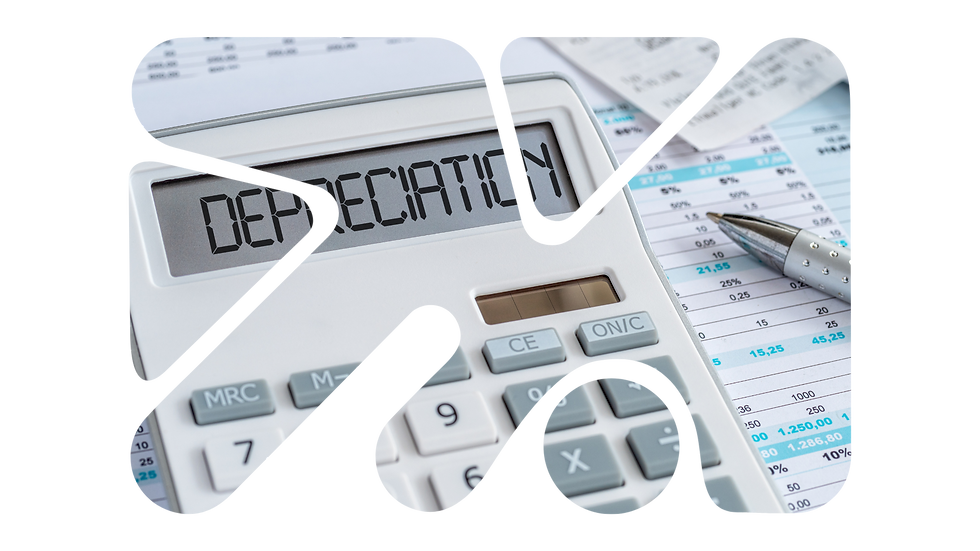The ABCs of Depreciation: A Simple Guide to Business Owners
- James L
- Jun 2, 2024
- 4 min read

Depreciation is an accounting concept that allocates the cost of an asset over its expected useful life. When businesses purchase assets, the cost of those assets are not expensed all at once. Instead, these costs are spread out over each asset's expected useful life. This process is known as depreciation. The concept of depreciation is critical to business decision making, as it allocates the cost of an asset over the years it is used, rather than expensing all of the cost in the year the asset is purchased. A portion of the asset's cost is expensed each year, reflecting the decrease in its value, as the asset is used up over time. This creates a more accurate representation of an asset's value, which in turn helps to improve financial reporting and decision-making. It’s important to remember that depreciation is not the same as physical wear and tear, although it is often related to it. Rather, depreciation is an accounting concept that is used to match the expense of using an asset with the revenue this asset generates.
Factors Affecting Depreciation
The amount of depreciation expense for an asset is determined by the following factors:
Cost of an Asset
Salvage Value
Useful Life of an Asset
Depreciation Method
Cost of an asset is the initial purchase price, including any installation or delivery costs.
Salvage Value is the estimated value of an asset at the end of its useful life. It represents the amount that a company expects to recover from selling or disposing of the asset.
Useful life is the estimated number of years an asset is expected to be used by the company. It considers factors such as technological advancements, physical wear and tear, and obsolescence.
Depreciation method refers to how a company will allocate the cost of an asset over its useful life.
Depreciation Methods
Depreciation method plays a key role in determining the amount of depreciation expense that a company will have in any given year. As stated above, depreciation method refers to how a company will allocate the cost of an asset over its useful life. There are several different methods of calculating depreciation. Each method would produce a different amount of depreciation expense in any given year. However, the total depreciation over all the years should add up to be the same, regardless of the depreciation method. Given that the depreciation method is a key factor in arriving at depreciation expense for any given year, let’s take a closer look at different types of depreciation methods.
Depreciation expense can be calculated using a variety of methods. Some of the most common methods include:
Straight-line depreciation
Declining balance depreciation
Sum-of-the-years' digits depreciation
Units of Production depreciation method
Straight-line depreciation is a method that allocates an equal amount of depreciation expense to each year over the asset's useful life.
Declining balance depreciation is a method that allocates a higher percentage of depreciation expense in the early years of an asset's useful life, and a lower percentage in the later years.
Sum-of-the-years' digits depreciation is a method allocates depreciation expense based on the number of years remaining in the asset's useful life.
Units of Production is a method based on the actual usage or production of the asset. The formula divides the depreciable cost of the asset by the total expected units it will produce over its life, then multiplies this rate by the units produced in a given period.
Journal Entry
Depreciation expense is recorded with the following journal entry:
Dr: Depreciation Expense XXX
Cr: Accumulated Depreciation XXX
Depreciation Expense and Accumulated Depreciation are the two accounts in our depreciation journal entry.
Depreciation Expense is an Income Statement Account. The balance of this account lowers total net income.
Accumulated Depreciation is a Balance Sheet account. It’s a contra-asset account that is used to track the total amount of depreciation that has been expensed for an asset over its useful life. This account has a normal credit balance. And it’s typically listed on the balance sheet directly below the corresponding asset account.
Calculating Depreciation under Straight Line Method
Let’s demonstrate how to calculate depreciation with a simple example:
Assume that a business purchased equipment with total cost of $10,000. The useful life of this equipment is expected to be 5 years. And it’s expected to have zero salvage value at the end of 5 years. This company uses straight-line method to calculate deprecation. The calculation is simple. Straight-line depreciation method allocates an equal amount of depreciation expense to each year over the asset's useful life. And there is no expected salvage value in our example. So, we’ll take total cost of equipment of $10,000 and divide it by 5 years of useful life of the asset. Our depreciation will come to $2,000 per year. And under the Straight line method, it will be the same amount of depreciation in each of the 5 years. This would not be the case under other methods of depreciation.
Depreciation Calculation under Straight Line Method
Depreciation = Total Cost of Asset – Salvage Value = $10,000 = $2,000
Useful life of an Asset 5
Below is the journal entry that we would make to record this transaction:
Dr: Depreciation Expense 2,000
Cr: Accumulated Depreciation 2,000
This entry debits Depreciation Expense for $2,000 and credits Accumulated Depreciation for $2,000.
Depreciation expense is an important accounting concept that enables businesses to allocate the costs of their assets over their expected useful life. Properly allocating the cost of an asset over years used, rather than expensing all of the cost in the year the asset is purchased, is critical to financial statements being accurate and reflecting the true value of the assets of the business. By understanding depreciation expense, as well as properly accounting for it, businesses can make more informed decisions about their assets and their finances.

